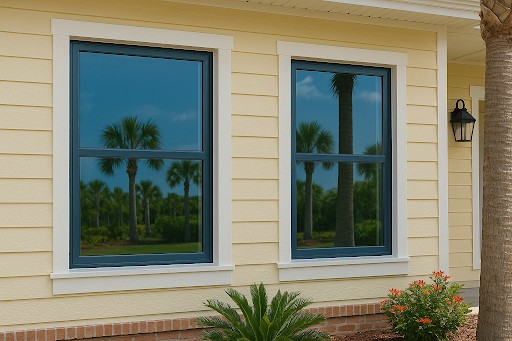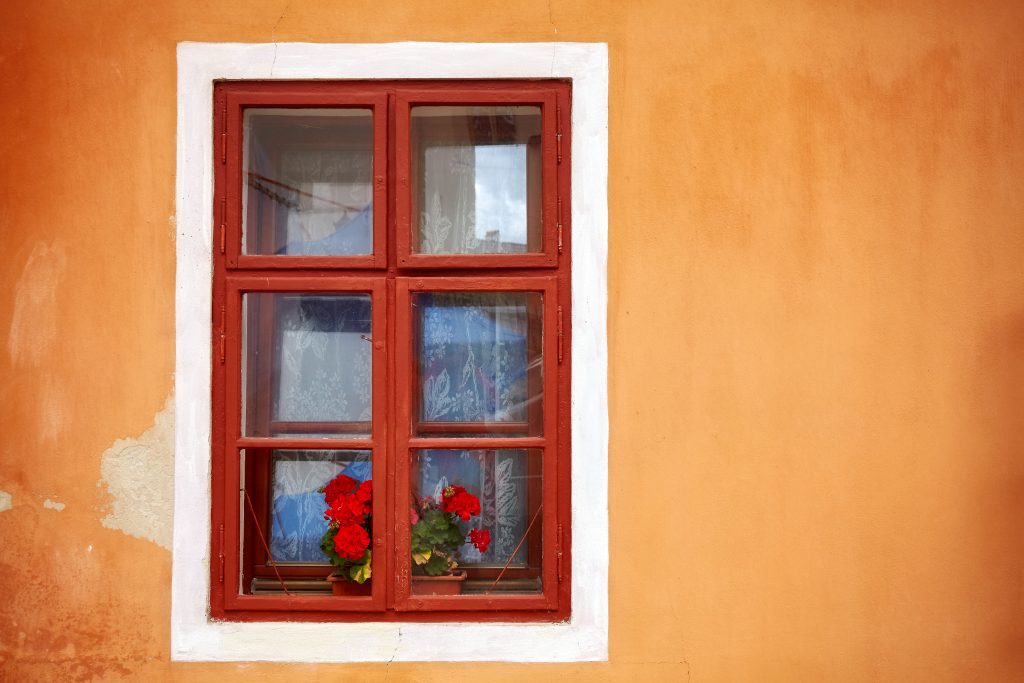When a homeowner starts researching window options in Florida, the first question usually isn’t about color or style. It’s about protection. Can these windows protect my home when the next hurricane hits?
Anyone who’s lived through a Gulf Coast storm season understands why this is important.

Regular windows use single-pane or double-pane glass held in place by standard aluminum or vinyl frames. The glass is ordinary annealed glass, the same type found in most homes across the country. When something strikes it hard enough, it shatters into sharp pieces.
The frames on these windows meet basic building codes for most of the United States, but they’re not built for Category 3 hurricanes. They’re designed to open and close, keep out rain on normal days, and provide a view.
A standard window might work fine in Ohio or Colorado, but Florida creates problems these products weren’t built to handle.
During hurricane season, wind speeds can exceed 150 miles per hour. At that speed, lawn furniture becomes airborne. Tree branches break loose. Regular windows break when debris hits them.
Storms aren’t the only problem:
Most homeowners with regular windows install separate hurricane shutters or plywood panels before every storm. That means buying supplies, spending hours on installation, and living without natural light while waiting for the weather to pass.

Impact windows use two panes of glass with a layer of polyvinyl butyral (PVB) sandwiched between them.
When something hits this laminated glass, it might crack. The outer pane might shatter. But the interlayer holds everything together, keeping the window intact and preventing breaches that allow wind and water inside.
The frames are reinforced with heavy-gauge aluminum or specially formulated vinyl that won’t bend or break under extreme pressure. The anchoring system goes deeper into the wall structure, spreading impact forces across a larger area.
The Florida Building Code requires strict testing before products can be installed in high-velocity hurricane zones, which cover most coastal areas.
Testing involves shooting a nine-pound 2×4 at the window at 34 miles per hour, then subjecting the assembly to thousands of pounds of pressure cycling. The window must remain intact without creating an opening larger than 3 inches.
Manufacturers stamp each approved product with an acceptance number. This certification tells inspectors, insurance companies, and homeowners that the window meets Florida’s standards. Without it, installation might not be legal in certain zones.
Impact windows keep your home sealed during severe weather. When wind can’t get inside, it can’t create the internal pressure that tears roofs off from the inside out.
Staying sealed also means staying dry. Water intrusion during a storm leads to mold, ruined belongings, and long insurance claims. Keeping water outside maintains normal conditions inside.
The same features that stop hurricanes also improve daily living. These year-round advantages include:
The multi-layer construction blocks exterior noise. Traffic sounds drop considerably. The neighbor’s dog becomes background noise instead of a loud disruption.
Insurance companies know impact windows reduce the chance of major loss during a storm. Many providers offer premium discounts of 15 to 30 percent when homes have properly rated hurricane protection installed.
The discount varies by location, coverage level, and insurance provider, but the savings add up. Over the typical 20-year lifespan of quality windows, that reduction in premiums can offset a large portion of the initial installation cost.
Some policies require hurricane protection in coastal zones. Installing impact windows satisfies that requirement while providing benefits that shutters or panels can’t match.

Not every Florida home faces the same threat level. Properties located 20 or 30 miles inland, away from direct coastal exposure, might sit in zones where building codes allow standard windows with separate storm protection.
Wind speeds drop as the distance from the coast increases. Hurricane strength diminishes after landfall. Homeowners in these areas can choose between impact windows and alternative protection methods.
However, storms don’t always follow expected patterns. Hurricane Irma maintained dangerous strength far inland in 2017. Hurricane Ian damaged areas that some considered relatively safe in 2022. The lower-risk zones keep getting smaller as weather patterns change.
Impact windows represent a larger upfront investment than standard windows. Costs vary widely based on home size, window quantity, style preferences, and product quality. Getting accurate estimates from local contractors is the best way to understand what fits your budget.
Some homeowners choose to upgrade gradually:
When comparing costs, consider the monthly financing expense against the combined cost of higher insurance premiums and repeated shutter installations. Looking at total costs over 10 or 20 years provides a clearer picture of long-term value.
Quality impact windows generally last 20 to 30 years with minimal maintenance. The laminated glass and reinforced frames resist damage better than standard windows, especially in Florida’s climate. Some manufacturers offer warranties extending 15 to 20 years.
This isn’t recommended. Impact windows require exact installation to maintain their storm rating. Wrong anchoring, poor sealing, or incorrect shimming can void warranties and reduce protection. Many areas require licensed contractors for hurricane-rated products, and insurance discounts often depend on professional installation with proper permits.
Yes, in most cases. Impact windows provide continuous protection without requiring installation before each storm. They satisfy Florida Building Code requirements for wind-borne debris protection in high-velocity hurricane zones. Some homeowners still add shutters for extra security on huge windows, but it’s not necessary for code compliance or insurance requirements.
No. Modern impact windows let in roughly the same amount of light as standard windows. The laminated interlayer and UV filtering don’t significantly affect brightness. Some homeowners notice improved lighting quality because the UV protection reduces glare while maintaining natural light levels.
Insurance savings vary by location, coverage type, and provider. Coastal homes in high-risk zones typically see discounts of 20 to 30 percent on wind coverage premiums. Homes further inland might see smaller reductions. Contact your insurance agent with product specifications before installation to get an exact quote. Some carriers require additional documentation or inspection after installation to activate the discount.
Finding a qualified installer matters as much as selecting the right windows. Good products fail when they’re installed poorly.
Look for contractors with extensive local experience in coastal installations. They should understand salt-air corrosion, humidity-related issues, and the specific permit requirements in your area. A crew that’s been installing windows along the Gulf Coast for decades knows which products last and which don’t.
Check that your contractor works with manufacturers holding current Florida Product Approval numbers. Verify that previous installations have survived recent hurricane seasons. Read reviews that mention both product quality and installation work.
Mr. Build brings nearly 50 years of experience to window installations throughout the Bradenton and Sarasota areas, with over 3,000 completed projects that have survived every major storm in recent decades.
The difference between impact windows and regular windows is significant. One provides basic functions. The other includes protection, lower energy bills, and less worry during the Gulf Coast storm season.
Every homeowner’s situation is different. Property location, budget, and personal needs all factor into the right choice. But understanding the real differences between these window types makes that decision easier.
Waiting for the next hurricane watch to start researching options is too late. Contractors book up weeks in advance once forecasts show storms approaching. Permits take time. Installation takes time. Contact professional window contractors to start the process now, before the next storm forms.